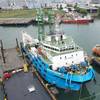With the liquefied natural gas (LNG) trade expected to significantly increase over the next decade, transporting LNG with carriers upwards of 33 percent larger than previous designs means particular attention must be addressed to key technical concerns to assure that the new generation of larger LNG carriers provides the same high degree of reliability as its predecessors.
Operators are driving the demand for increased size of these specialized vessels to take advantage of the economies of scale. “By increasing the size of the standard LNG carrier from about 145,000m3 (cubic meters) to 200,000m3 and even larger, it is estimated that there could be a reduction in transportation costs by as much as 15 percent,” says ABS Senior Consultant, Energy Project Development Group, James Gaughan. Another distinct advantage with larger LNG ship designs is a reduction in the amount of cargo boiled off as a percentage of volume. The expected boil-off rate for the larger designs will be no more than 13 percent versus the current range of 15 to 25 percent.
With over 50 years of experience classing LNG carriers, ABS has the distinction of having classed LNGs built with all types of accepted containment systems. Drawing upon this experience has uniquely positioned ABS to extrapolate data from the previous generation of LNG ships in the 133,000m3 to 148,000m3 range to designs now ranging upwards of 200,000m3 to 250,000m3.
Historically, over the last 10 years the increase in size of LNG carriers has been fairly gradual, observes Mumtaz Mahmood, Manager, Technology Development, ABS Europe. “The size increases being contemplated for the new breed of LNG carriers right now in the 200,000m3 to 250,000m3 range is significant. The entire design of the ship structure and containment system requires evaluation to ensure its adequacy to withstand the additional loads.”
April 2025
 Read the Magazine
Read the Magazine

 Read the Magazine
Read the Magazine
This issue sponsored by:

Saltchuk Doubles Down on Workforce Development Investments
Subscribe for
Maritime Reporter E-News
Maritime Reporter E-News is the maritime industry's largest circulation and most authoritative ENews Service, delivered to your Email five times per week












